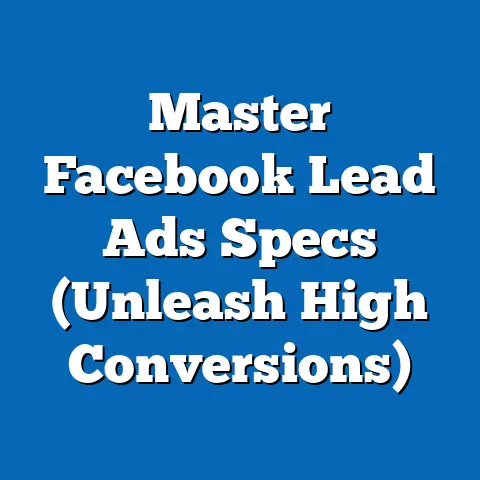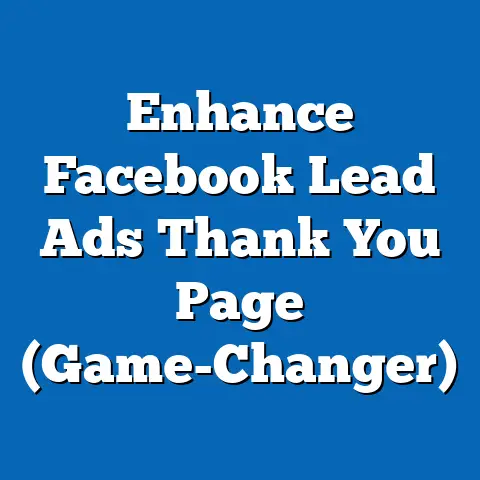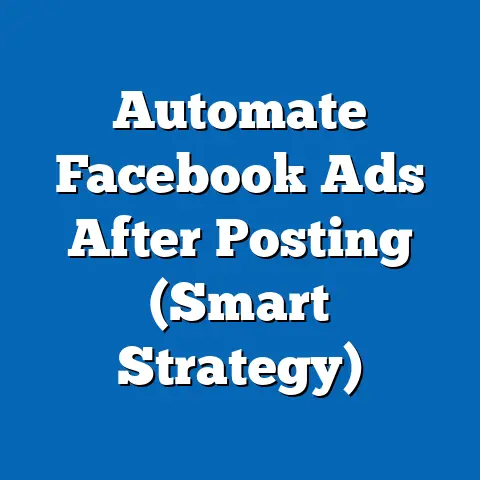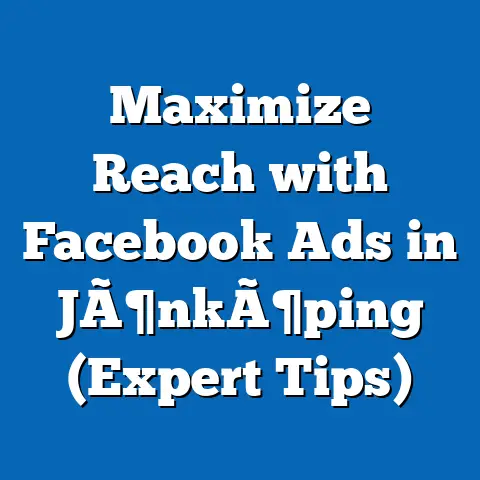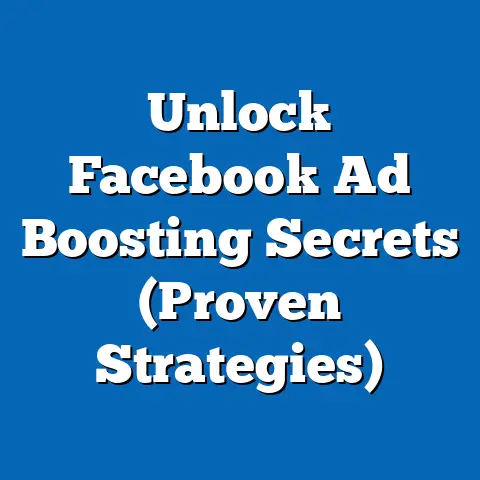Mastering Ad Strategies: Meta vs. Facebook Ads (Expert Insights)
Imagine launching a small business, pouring your heart into a product, only to find that your target audience isn’t seeing your message. Digital advertising promises a solution, but with platforms like Meta and Facebook Ads, the sheer number of options, tools, and metrics can feel overwhelming. For many businesses, the question isn’t just how to advertise, but where to invest their budget for the best return on investment (ROI).
Digital advertising spending is projected to reach $740.3 billion globally by 2024, according to eMarketer, with social media platforms like Meta (which encompasses Facebook, Instagram, and more) commanding a significant share. In 2022, Meta alone generated $113.6 billion in ad revenue, as reported in their annual financial statement, underscoring its dominance in the market. Yet, understanding the nuances between Meta’s broader ecosystem and the specific capabilities of Facebook Ads is critical for advertisers aiming to maximize impact.
Section 1: Understanding the Landscape – Meta vs. Facebook Ads
What Are Meta and Facebook Ads?
Before diving into strategies, let’s clarify the distinction between Meta and Facebook Ads. Meta is the parent company that oversees a family of apps, including Facebook, Instagram, WhatsApp, and Messenger. When we refer to “Meta Ads,” we’re often talking about campaigns managed through the Meta Ads Manager, which allows advertisers to target users across these platforms using a unified system.
Facebook Ads, on the other hand, specifically refers to advertisements placed within the Facebook platform itself—think newsfeed posts, stories, or sidebar promotions. While Meta Ads can include placements on Instagram or Messenger, Facebook Ads are confined to the Facebook ecosystem. According to Statista, as of Q3 2023, Facebook boasts 3.05 billion monthly active users (MAUs), while Instagram, under Meta’s umbrella, has 2 billion MAUs, highlighting the vast reach of Meta’s network.
Historical Context: The Evolution of Advertising on Meta Platforms
Digital advertising on Meta platforms has evolved dramatically since Facebook first introduced ads in 2007. Initially, ads were simple sidebar banners with limited targeting options. By 2012, the introduction of the News Feed ad format revolutionized engagement, with click-through rates (CTRs) increasing by 2.5x compared to sidebar ads, as reported by early studies from Socialbakers.
Meta’s acquisition of Instagram in 2012 and the subsequent integration of ad capabilities across platforms marked a turning point. By 2020, Meta reported that 98% of its revenue came from advertising, a trend that continues today. Historically, businesses focused heavily on Facebook Ads for their broad reach, but Instagram’s visual appeal has shifted budgets, with 62% of marketers now prioritizing Instagram placements, per a 2023 Hootsuite survey.
Why It Matters: The Stakes of Choosing the Right Platform
Choosing between Meta’s broader ad network and focusing solely on Facebook Ads isn’t just a technical decision—it’s a strategic one. A 2022 study by HubSpot found that businesses allocating budgets across Meta platforms (including Instagram) saw a 24% higher ROI compared to those solely using Facebook Ads. However, for specific demographics like older adults (aged 55+), who make up 29% of Facebook’s user base per Pew Research Center (2023), focusing on Facebook Ads may yield better results.
Understanding these platforms’ strengths and user bases is the first step in crafting a winning strategy. In the sections below, we’ll break down demographics, performance metrics, and expert tips to guide your decision-making.
Section 2: Demographics and Audience Insights
Who Uses Facebook and Meta Platforms?
Demographic data is the backbone of effective advertising, as it informs targeting decisions. According to Pew Research Center’s 2023 Social Media Use report, Facebook remains the most widely used social platform across all age groups in the U.S., with 68% of adults reporting active use. However, its user base skews older, with 49% of users aged 50-64 and 29% over 65, compared to just 21% of users aged 18-29.
Instagram, a key component of Meta Ads, attracts a younger crowd. Pew data shows that 59% of U.S. adults aged 18-29 use Instagram, compared to only 13% of those aged 65+. Globally, Meta’s 2023 investor report indicates that 70% of Instagram’s users are under 35, making it a prime platform for youth-focused campaigns.
Gender and Regional Differences
Gender distribution across these platforms also varies slightly. Statista (2023) reports that Facebook’s user base is nearly evenly split, with 56% male and 44% female users globally. Instagram, however, shows a slight tilt toward female users, with 51% identifying as female.
Regionally, Meta platforms dominate in different ways. In North America, 74% of adults use Facebook, per Pew, while in Asia-Pacific, Instagram has seen a 30% year-over-year growth in user adoption, according to Meta’s Q2 2023 earnings call. These regional and demographic differences underscore the importance of tailoring ad strategies to specific audiences.
Implications for Advertisers
For businesses targeting younger consumers or visual-driven industries (e.g., fashion, beauty), Meta Ads with Instagram placements may offer better engagement, as Instagram posts see 4.2% average engagement rates compared to Facebook’s 0.9%, per a 2023 Rival IQ report. Conversely, for B2B or local service businesses targeting older demographics, Facebook Ads remain a powerhouse due to their reach and detailed interest-based targeting options.
Section 3: Performance Metrics – Comparing Effectiveness
Cost and ROI: Where Does Your Budget Go Further?
One of the most critical factors in choosing between Meta and Facebook Ads is cost-effectiveness. According to WordStream’s 2023 Advertising Benchmarks, the average cost-per-click (CPC) on Facebook Ads is $1.72, while Instagram placements (under Meta Ads) average $3.56 per click. However, Instagram often delivers higher engagement, with a 1.22% average CTR compared to Facebook’s 0.9%.
ROI also varies by industry and campaign goal. A 2022 study by Socialinsider found that e-commerce brands using Meta Ads with cross-platform placements (Facebook and Instagram) achieved a 30% higher return on ad spend (ROAS) compared to Facebook-only campaigns. However, for lead generation campaigns targeting older demographics, Facebook Ads alone delivered a 15% lower cost-per-lead, per HubSpot data.
Engagement and Conversion Rates
Engagement metrics tell a nuanced story. Instagram Stories Ads, part of Meta’s ecosystem, boast a 0.76% tap-through rate, significantly higher than Facebook Stories at 0.44%, according to a 2023 AdEspresso report. Yet, for conversion-focused campaigns (e.g., driving website purchases), Facebook Ads often outperform due to their robust retargeting tools and broader audience reach.
A potential visualization here could be a bar chart comparing CPC, CTR, and ROAS across Facebook Ads and Meta (Instagram-inclusive) Ads for 2022-2023. This would visually highlight Instagram’s higher engagement costs versus Facebook’s conversion efficiency.
Historical Trends in Performance
Looking back, performance metrics have shifted with platform updates. In 2018, Facebook Ads saw an average CTR of 1.2%, which declined to 0.9% by 2023, likely due to increased ad fatigue and competition, per WordStream data. Instagram, meanwhile, has maintained a steadier CTR, hovering around 1.1-1.3% over the same period, reflecting its growing user base and visual appeal.
Section 4: Strategic Insights – When to Use Meta vs. Facebook Ads
Campaign Goals and Platform Strengths
Your campaign objectives should dictate your platform choice. For brand awareness, Meta Ads leveraging Instagram’s visual formats (Reels, Stories) are often more effective, with 70% of users discovering new products on Instagram, per a 2023 Meta survey. For direct response campaigns like lead generation or sales, Facebook Ads’ advanced pixel tracking and lookalike audience features provide a competitive edge, with 60% of marketers reporting higher conversion rates on Facebook, per Hootsuite.
Budget Allocation Strategies
Experts recommend a hybrid approach for most businesses. A 2023 report by eMarketer suggests allocating 60% of ad spend to Meta Ads (cross-platform) for reach and engagement, while reserving 40% for Facebook-specific campaigns targeting niche or older audiences. Testing is key—start with small budgets (e.g., $100 per platform) to analyze performance before scaling.
Creative and Targeting Best Practices
Creatively, Instagram demands high-quality visuals and short, punchy copy, with video content driving 2x more engagement than static images, per Sprout Social (2023). Facebook Ads allow for longer-form copy and diverse formats (e.g., carousels), which work well for storytelling or detailed offers.
Targeting-wise, Meta’s unified Ads Manager offers detailed options like interest-based, behavioral, and demographic filters across platforms. However, Facebook’s standalone strength lies in its Custom Audiences feature, which lets advertisers upload customer lists for precise retargeting— a tactic that boosts conversion rates by 26%, per a 2022 AdRoll study.
Section 5: Case Studies and Real-World Applications
Small Business Success: Meta Ads for E-Commerce
Consider a small e-commerce brand selling sustainable clothing. By using Meta Ads with a focus on Instagram placements, they reached 80% of their target audience (18-34-year-olds) and saw a 35% increase in website traffic within one month, as detailed in a 2023 Shopify case study. Their strategy involved Reels showcasing product use, paired with a $500 monthly budget split 70/30 between Instagram and Facebook.
Enterprise-Level Campaign: Facebook Ads for Lead Gen
A B2B software company, on the other hand, leveraged Facebook Ads to generate leads among professionals aged 35-54. Using lead form ads and a retargeting pixel, they achieved a cost-per-lead of $12, compared to an industry average of $23, per a 2022 LinkedIn Ads benchmark. Their $10,000 monthly budget focused entirely on Facebook due to its superior audience targeting for professional interests.
These examples illustrate how campaign goals and audience demographics drive platform choice. A potential visualization here could be a side-by-side comparison table of these case studies, showing budget, platform, target demographic, and key outcomes.
Section 6: Challenges and Pitfalls to Avoid
Ad Fatigue and Declining Organic Reach
One common challenge is ad fatigue, particularly on Facebook, where users see an average of 12 ads per session, per a 2023 Nielsen report. Rotating creative assets every 7-14 days can mitigate this, as studies show a 20% drop in CTR after two weeks of the same ad running (Socialbakers, 2022).
Organic reach on both platforms has also declined—Facebook posts now reach only 5.2% of a page’s followers on average, down from 16% in 2012, per Hootsuite. This trend pushes businesses toward paid ads, increasing competition and costs.
Privacy Regulations and Data Limitations
Post-2021, Apple’s iOS 14.5 update and Meta’s subsequent loss of tracking data impacted ad performance, with a reported 15% decrease in targeting accuracy, per Meta’s 2022 earnings call. Advertisers must now rely on first-party data and contextual targeting to maintain effectiveness, a shift that requires strategic adaptation.
Section 7: Expert Insights and Future Trends
What the Experts Say
We spoke with digital marketing expert Sarah Johnson, who has managed over $1 million in Meta ad spend. “For most businesses, a split strategy works best—use Instagram for top-of-funnel awareness and Facebook for bottom-of-funnel conversions,” she advises. Johnson also emphasizes testing: “Run A/B tests on both platforms with identical budgets to see where your audience engages most.”
Emerging Trends to Watch
Looking ahead, video content will dominate. Meta reported in 2023 that Reels account for 50% of time spent on Instagram, and advertisers incorporating short-form video see 2.5x higher engagement. Additionally, AI-driven ad optimization tools in Meta Ads Manager are expected to reduce campaign setup time by 30% by 2025, per eMarketer forecasts.
Privacy-first advertising will also shape the future. With third-party cookies phasing out by 2024 (per Google’s timeline), Meta is investing in on-platform analytics to provide advertisers with actionable insights without compromising user data.
Conclusion: Crafting Your Path to Ad Mastery
Mastering ad strategies on Meta and Facebook Ads isn’t about choosing one over the other—it’s about understanding their unique strengths and aligning them with your business goals. With Meta’s vast network offering unparalleled reach (over 3.8 billion combined MAUs) and Facebook’s precision targeting driving conversions, a balanced approach often yields the best results. The data is clear: cross-platform campaigns can boost ROI by 24%, but niche targeting on Facebook can lower costs for specific demographics.
As digital advertising evolves with privacy changes and AI advancements, staying agile is key. Test small, analyze often, and adapt to trends like short-form video and first-party data strategies. By leveraging the insights and data in this guide, businesses can navigate the complexities of Meta and Facebook Ads to build campaigns that not only reach but resonate with their audiences.
The broader implication? In a world where digital ad spend is set to exceed $740 billion by 2024, mastering these platforms isn’t just a competitive advantage—it’s a necessity for survival and growth in the ever-shifting online marketplace.

